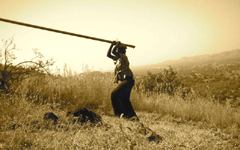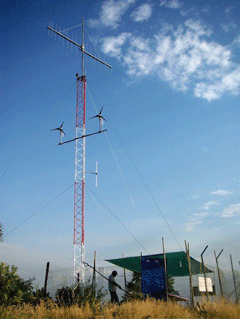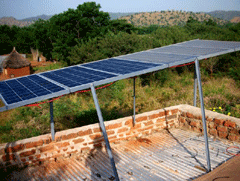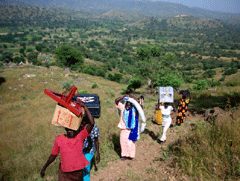After War, Wind-Powered Radio
Air Date: Week of December 5, 2008

A local woman carries part of a windmill up Kauda mountain to power her local radio station. (Courtesy of Internews)
In Southern Sudan electricity is virtually non-existent after 22 years of civil war. Host Bruce Gellerman talks with Internews program director Deborah Ensor about bringing solar and wind energy to the region to power a new radio station.
Transcript
GELLERMAN: It’s Living on Earth. I’m Bruce Gellerman.
[SOUND OF RADIO MUSIC BROADCAST]
GELLERMAN: From one of the most remote places on the planet, a familiar sound – radio - a critical link, empowering the people of southern Sudan.
[SUDAN RADIO: This is the voice….[foreign language] This is your community radio.]
GELLERMAN: For more than two decades southern Sudan was the scene of one of the longest lasting wars of the 20th century. Before it ended three years ago, nearly two million civilians were killed and four million southerners were forced to flee their homes. Now people are returning and radio is helping to heal the nation. John Mussa is a reporter with Internews in southern Sudan. Internews is an international nonprofit organization that works to improve access to information for people around the world by fostering an independent media.
MUSSA: Nuba Mountain is a part of Sudan. It has never seen a development before and after independence of Sudan. It was the dream of a number of people to have radio. Because it's a simple way to give a message.
GELLERMAN: In the case of Sudan, Internews built four radio stations in the civil-war-torn south, and powers them with sustainable, renewable energy.
Deborah Ensor is Internews’s program director in Sudan.

This transmission tower had to be located at the top of Kauda Mountain to broadcast to a larger local audience. (Courtesy of Internews)
ENSOR: Since the war ended in south Sudan about three years ago, there’s no real infrastructure here, there’s no way for people to get information. There’s not a lot of printing presses, there’s not a lot of newspapers. A lot of people can’t read because there hasn’t been schools in south Sudan for many, many years. So radio is a really great way to reach people.
GELLERMAN: Radio is a really powerful medium, but how do you get power for your radio stations?
ENSOR: As I was saying earlier, there’s no infrastructure in south Sudan or very limited infrastructure. Which means there’s no electricity. So everything is powered by generators, and generators are expensive and they’re somewhat difficult to maintain. So in some of our stations we use solar and wind power. Sudan is a very hot place. It’s very dry half of the year, and so the sun is a really, really great way to power some of the stations.

100 percent of the power for the Kauda station’s transmission tower comes from sun and wind, while the radio station in the valley uses solar panels backed up with generators. (Courtesy of Internews)
GELLERMAN: Some of these radio stations are located in incredibly remote mountainous regions.
ENSOR: Yes. Our station in Kauda which is in the Nuba Mountains in south Sudan is a very remote location. It’s very mountainous. So when you’re trying to send out a radio signal, it’s very limited in its range because there’s so many mountains around, it just sort of gets stuck in the valley. So we had to put our transmission tower in a remote transmission site, so way up on top of this hill in the mountains. Getting it up there was a whole 'nother matter in and of itself. We had over a ton of equipment that had to go on the top of this mountain, including six batteries that weigh about 60 kilograms a piece, four mast sections, more than 50 kilograms of tools, every day that had to go up and down. It’s like a 90 minute hike to get up the hill. The temperature is 105, 110 degrees. And there’s no vehicles that can go up there. So we hired a lot of local women from the community. They carried up all of the equipment - something like 20 kilos per load on their heads. And it’s amazing. I would go up this hill and I would be so plum tuckered by the time I got up there and I’m not even carrying anything, but myself and a bottle of water, you know. And these women are carrying 20 or 30 kilos on top other their head and they’re walking barefoot or in sandals, and they’re laughing and singing along the way, and it was very easy for them.
GELLERMAN: Deb, why women? Didn’t the men do this?
ENSOR: You know the men did other jobs. The men carried the batteries because it took four men to carry one battery because they’re so heavy. But generally speaking, women do a lot of the work.
GELLERMAN: You sent us some audio from going up this mountain. Let’s listen to it now.
DOBBING: We’re just approaching the roof of the community mast on top of the mountain.
ENSOR: This is Ellie Dobbing. She’s our media training manager.
DOBBING: We’ve walked up to look at it. [Panting] You can hear the wind turbines spinning. [Walking]

Local women carry supplies to a new transmission tower at the top of Kauda Mountain. (Courtesy of Internews)
GELLERMAN: So Deb, how do people power their radios, if there’s no electricity available?
ENSOR: There’s several NGOs that give out radios as part of their projects and they are these terrific little solar powered and hand crank radios.
GELLERMAN: I understand you have a power with roaming cows and goats affecting the station. How’s that?
ENSOR: [Laughs] Yeah, well, you know, all of these areas are agricultural areas. Everyone has cows, everyone has goats. They just sort of free roam anywhere and [laugh] you’re trying to record on the air and you can hear in the background the bleating of goats, you know, the feet of cows padding by. So you have to be very careful when you’re setting up sensitive equipment to make sure that it’s fenced off very well so that roaming animals don’t destroy it by accident.
GELLERMAN: Deb, this is community radio that you’re doing, this is run by the people who live there. Have they ever done community radio, or any radio?

A local woman carries part of a windmill up Kauda mountain to power her local radio station. (Courtesy of Internews)
[SUDAN RADIO: FOREIGN LANGUAGE, DRUMMING]
ENSOR: The communities are just thrilled with these stations, you know, they’re so excited to hear them. It’s fantastic, just the enthusiasm and the excitement for people to be able to hear radio and to hear it in their own language. We broadcast in more than ten different languages.
[SUDAN RADIO: VOICES IN FOREIGN LANGUAGES, MUSIC]
ENSOR: It provides them with information about so many things, things like early marriage and why is it important for young girls to stay in school, you know, if there’s a malaria outbreak, the station informs what to do and where it’s happening. And there’s a lot of really funny, great, wonderful little things too. You know, they have these community hours where people in the community can just come to the station and make announcements on the air. They talk about their lost cows, they come in to sing folk songs, and they just really grasp on to it and really participate.
GELLERMAN: I’ve consulted with Internews overseas and I’ve worked with them with setting up radio stations around the world. Where does it go from here, Deb?
ENSOR: What we’re trying to do is build the capacity of the staff and of the community to be able to run the station on their own. The idea is that at the end of the day Internews will leave and these stations will remain behind and there’ll be a cadre of journalists that are able to put together accurate and fair and interesting information for their communities and that they can do it on their own.
GELLERMAN: Deborah, thanks a lot. Appreciate it.
ENSOR: Thanks a lot, Bruce. I appreciate it too.
[RADIO SOUND]
GELLERMAN: Deborah Ensor is Program Director for Internews in Sudan, where the wind and sun are powering radio stations and empowering people.
Links
Living on Earth wants to hear from you!
Living on Earth
62 Calef Highway, Suite 212
Lee, NH 03861
Telephone: 617-287-4121
E-mail: comments@loe.org
Newsletter [Click here]
Donate to Living on Earth!
Living on Earth is an independent media program and relies entirely on contributions from listeners and institutions supporting public service. Please donate now to preserve an independent environmental voice.
NewsletterLiving on Earth offers a weekly delivery of the show's rundown to your mailbox. Sign up for our newsletter today!
 Sailors For The Sea: Be the change you want to sea.
Sailors For The Sea: Be the change you want to sea.
 The Grantham Foundation for the Protection of the Environment: Committed to protecting and improving the health of the global environment.
The Grantham Foundation for the Protection of the Environment: Committed to protecting and improving the health of the global environment.
 Contribute to Living on Earth and receive, as our gift to you, an archival print of one of Mark Seth Lender's extraordinary wildlife photographs. Follow the link to see Mark's current collection of photographs.
Contribute to Living on Earth and receive, as our gift to you, an archival print of one of Mark Seth Lender's extraordinary wildlife photographs. Follow the link to see Mark's current collection of photographs.
 Buy a signed copy of Mark Seth Lender's book Smeagull the Seagull & support Living on Earth
Buy a signed copy of Mark Seth Lender's book Smeagull the Seagull & support Living on Earth

